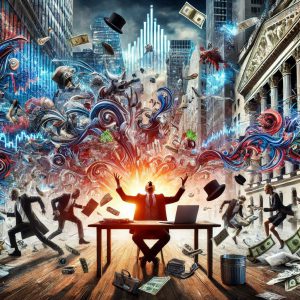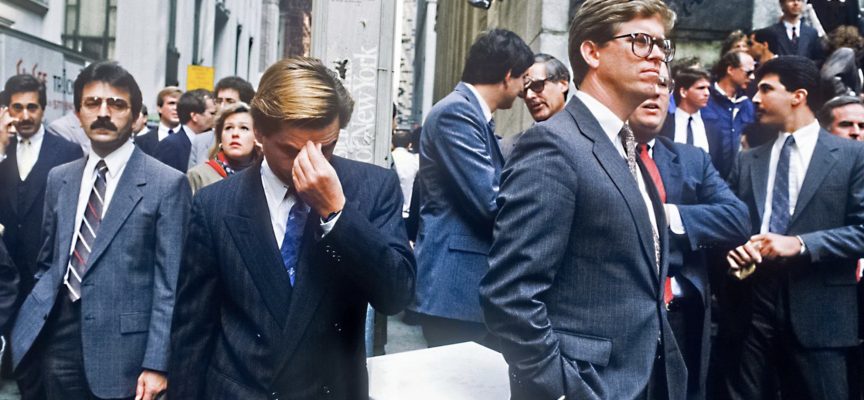Black Monday: The Day Wall Street Fell
On October 19, 1987, global stock markets experienced one of the most dramatic single-day declines in history, an event that would come to be known as “Black Monday.” The Dow Jones Industrial Average plummeted 22.6%, its largest one-day percentage drop ever. This financial earthquake sent shockwaves through markets worldwide, leaving investors shell-shocked and economists scrambling for explanations. The reverberations of Black Monday continue to echo through financial history, offering valuable lessons about market psychology, systemic risks, and the delicate balance of global finance.
The Perfect Storm: Factors Leading to the Crash
The causes of Black Monday were complex and multifaceted, involving a confluence of economic, technological, and psychological factors. In the months leading up to October 1987, the bull market had been running hot, with the Dow gaining over 40% in the first eight months of the year. This rapid ascent had pushed valuations to historically high levels, creating a potentially unstable situation.
Warren Buffett, the legendary value investor, had warned about the dangers of overvaluation in the months preceding the crash. He famously said, “Be fearful when others are greedy, and greedy when others are fearful.” In the context of Black Monday, this wisdom proved prescient, as the market’s greed-driven ascent set the stage for a fear-driven collapse.
Several macroeconomic factors also contributed to market jitters. Rising interest rates, a weakening dollar, and growing trade deficits created uncertainty about the U.S. economy’s future. These concerns were exacerbated by geopolitical tensions, including conflicts in the Persian Gulf.
The Role of Program Trading and Portfolio Insurance
A critical factor in the severity of the Black Monday crash was the widespread use of computer-driven trading strategies, particularly portfolio insurance. This technique, designed to protect large institutional investors from market downturns, involved selling stock index futures as the market declined. In theory, this would offset losses in the underlying stock portfolio.
However, as John Bogle, founder of Vanguard and pioneer of index investing, later observed, “The idea that you can use futures for portfolio insurance is one of the most mischievous ideas that’s ever come into Wall Street.” The problem was that as more investors adopted these strategies, they created a self-reinforcing cycle of selling pressure.
On Black Monday, as the market began to decline, portfolio insurance programs triggered widespread selling of futures contracts. This, in turn, led to further declines in the stock market, triggering more selling. The result was a cascade effect that overwhelmed the market’s normal stabilizing mechanisms.
Mass Psychology and Market Panic
The events of Black Monday offer a stark illustration of the power of mass psychology in financial markets. As prices began to fall rapidly, fear and panic spread among investors, leading to a classic “flight to quality” as traders rushed to sell stocks and move into safer assets like Treasury bonds.
George Soros, the renowned hedge fund manager known for his theory of reflexivity, has often spoken about the self-reinforcing nature of market trends. In the context of Black Monday, Soros’s insights are particularly relevant. He argues that market participants’ perceptions can influence the fundamentals they are trying to reflect, creating feedback loops that can lead to extreme outcomes.
This psychological cascade was evident on Black Monday, as the initial decline in prices led to increased selling pressure, which in turn caused further price declines. This self-reinforcing cycle of fear and selling created a market environment where rational analysis was overwhelmed by emotional reactions.
Cognitive Biases in Action
The Black Monday crash also provides a vivid example of how cognitive biases can influence investor behaviour. One particularly relevant bias is the availability heuristic, where people judge the likelihood of an event based on how easily they can recall similar occurrences. Before Black Monday, many investors had become complacent due to the long-running bull market, underestimating the possibility of a severe market downturn.
Charlie Munger, Warren Buffett’s long-time business partner and a student of human psychology, has often spoken about the importance of understanding cognitive biases in investing. He once said, “The psychology of misjudgment is a terribly important thing to learn.” The events of Black Monday underscore this point, demonstrating how collective cognitive biases can contribute to market instability.
Technical Analysis and Market Signals
From a technical analysis perspective, there were warning signs in the market before Black Monday. The Dow had reached a then-record high of 2,722 points in August 1987, but had begun to show signs of weakness in the weeks leading up to the crash. Many technical indicators, such as the advance-decline line and the number of stocks making new highs versus new lows, had been diverging from the market’s upward trend.
William O’Neil, founder of Investor’s Business Daily and developer of the CAN SLIM investment strategy, has emphasized the importance of recognizing these technical warning signs. He argues that investors should pay close attention to the market’s overall health, not just individual stock prices. In the case of Black Monday, these broader market indicators were flashing warning signs that many investors overlooked.
The Global Nature of the Crash
One of the most striking aspects of Black Monday was its global nature. Markets around the world experienced severe declines, highlighting the increasing interconnectedness of global finance. The crash began in Hong Kong and spread westward through European markets before hitting the United States.
John Templeton, a pioneer of global investing, often spoke about the importance of looking beyond one’s home market. The events of Black Monday underscored this point, demonstrating how financial contagion could spread rapidly across borders. This global dimension added to the sense of panic, as investors realized that there was nowhere to hide from the market turmoil.
The Role of Market Makers and Liquidity
One factor that exacerbated the severity of the crash was the failure of many market makers to fulfill their role of providing liquidity. As selling pressure mounted, many market makers stepped away, refusing to buy stocks or quoting extremely wide bid-ask spreads. This lack of liquidity further fueled the market’s decline.
Paul Tudor Jones II, a hedge fund manager who famously predicted and profited from the 1987 crash, has spoken about the importance of understanding market structure and liquidity dynamics. He once said, “The most important rule of trading is to play great defence, not great offence.” On Black Monday, the breakdown of normal market-making activities highlighted the crucial role that liquidity plays in maintaining orderly markets.
The Aftermath and Policy Responses
In the immediate aftermath of Black Monday, there were fears of a repeat of the Great Depression. However, swift action by the Federal Reserve, led by Chairman Alan Greenspan, helped stabilize the markets. The Fed issued a statement pledging to provide liquidity to support the financial system and quickly lowered interest rates.
Ray Dalio, founder of Bridgewater Associates, has often emphasized the importance of understanding how policy responses can shape market outcomes. The Fed’s actions after Black Monday demonstrated the powerful role that central banks can play in stabilizing financial markets during times of crisis.
In addition to monetary policy responses, regulators implemented several changes to market structure in the wake of Black Monday. These included the introduction of circuit breakers, which automatically halt trading if the market falls by a certain percentage, and limits on program trading.
Lessons Learned and Long-Term Implications
Black Monday served as a wake-up call for investors and regulators alike, highlighting the potential for sudden, severe market dislocations. It underscored the importance of risk management and the dangers of overreliance on computer models that may not adequately account for extreme events.
Benjamin Graham, often referred to as the father of value investing, famously said, “In the short run, the market is a voting machine but in the long run, it is a weighing machine.” The events of Black Monday demonstrated the truth of this statement, showing how short-term market movements can be driven by fear and speculation rather than fundamental value.
For long-term investors, Black Monday reinforced the importance of maintaining a disciplined approach. As Peter Lynch, the legendary Fidelity fund manager, often advised, “The key to making money in stocks is not to get scared out of them.” Those who held steady or even bought during the panic were rewarded as the market recovered relatively quickly, with the Dow regaining its pre-crash level by early 1989.
The Legacy of Black Monday
More than three decades later, Black Monday remains a pivotal event in financial history. It serves as a reminder of the market’s capacity for extreme movements and the importance of preparing for tail risks. The crash also accelerated trends towards globalization and computerization in financial markets, shaping the modern trading landscape.
Jesse Livermore, a legendary trader from the early 20th century, once said, “There is nothing new in Wall Street. There can’t be because speculation is as old as the hills. Whatever happens in the stock market today has happened before and will happen again.” While the specific circumstances of Black Monday may not be repeated, the underlying lessons about market psychology, systemic risk, and the importance of liquidity remain highly relevant today.
As we reflect on Black Monday, it’s worth considering the words of Carl Icahn, the activist investor: “The key to success is to keep growing in all areas of life – mental, emotional, spiritual, as well as physical.” For investors and market participants, this means continually learning from past events like Black Monday, adapting to new market realities, and always staying vigilant for the next potential market-moving event.
Conclusion: Black Monday’s Enduring Relevance
Black Monday stands as a stark reminder of the market’s capacity for extreme movements and the complex interplay of factors that can lead to financial crises. It highlights the importance of understanding market psychology, the potential pitfalls of new technologies, and the crucial role of liquidity in maintaining market stability.
As Jim Simons, the mathematician and hedge fund manager, once observed, “The best way to make money is to have a lot of uncorrelated bets.” The events of Black Monday underscore the wisdom of this approach, demonstrating the dangers of overconcentration and the value of diversification.
Ultimately, Black Monday is a powerful lesson in humility for all market participants. It reminds us that no matter how sophisticated our models or how long a bull market has run, the potential for sudden, severe market dislocations always exists. By studying and understanding events like Black Monday, investors and policymakers can work to build more resilient financial systems and develop strategies to navigate future market turbulence.
Other Articles of Interest

Is withholding information manipulation?

How do I know my socioeconomic status?

How did the stock market panic 2020 reshape investor strategies?

Could the stock market panic of 1907 happen again?

How does the stock market trend after election affect investments?

How did the GameStop saga of 2021 reshape the stock market?

